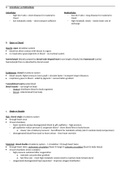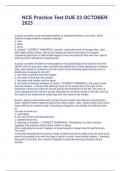Summary
Summary WJEC (England) Eduqas A-Level Biology 3. Requirements for life - 2. Animal Transport
- Course
- Institution
I achieved a high A* Grade in my final A-Level exams using these notes!!! I believe you can achieve an A* if you can memorise these notes! Simply use blurting, a method of active recall, to write everything you remember from the notes, then identify the parts you couldn’t remember, then repeat ...
[Show more]




